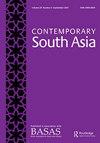Cancer and the Kali Yuga: gender, inequality and health in South India
IF 0.8
3区 社会学
Q3 AREA STUDIES
引用次数: 2
Abstract
the process, this section provides an understanding as well as a comparative assessment of the NDTV and Aaj Tak brands of journalism. The focus sharpens as the book deals with viewers’ consumption of the output of these two media channels and the nature of engagement between the producers and consumers of news. Finally, the book showcases the consequences of how all this gets played out within the public domain. In so doing, the reader gets to see the pressure faced by the media to deliberately frame discourse in their search for audience numbers within the wider compulsions of commerce. The book concludes that this pressure affects the ability of television media to stay true to responsible journalism and in the long run, disrupt the diversity and plurality of Indian democracy itself. Overall, this bookbrings to the surface several very importantpoints. It demonstrates thehuge impact televisionnewshas in India,with its reach to over abillionpeople and its ability to shapepublic discourse. Secondly, the book provides insights into the huge transformation of television media in terms of the way it is structured and operates. It makes a compelling case for regulation to keep pace with the changes television media has gone through in representing, producing and shaping consumption of news. It highlights the way media channels frame debates, including their similarities and differences. Finally, and most importantly, how, under pressure, television news media reconstruct reality which in turn leads to, in some cases, the failure to uphold the values and norms of responsible journalism. This book presents an analysis which would whet the appetite of a wide range of readers whose interests lie in sociology, media and communication studies, popular culture and South Asian studies. For those whose interests are primarily Indian culture and identities this is a compelling read on two private Indian national television news channels and their capacity to thrive and shape public discourse in contemporary India. It is a great read for students of media who wish to chart the rapid growth and transformation of Indian media in general and television news media in particular. For students of Indian politics, this book provides a fascinating insight into the pressures faced by the fourth column within a democratic framework.癌症与卡利尤加:南印度的性别、不平等与健康
在这个过程中,本节提供了对NDTV和Aaj Tak新闻品牌的理解和比较评估。随着这本书涉及观众对这两个媒体渠道输出的消费以及新闻生产者和消费者之间互动的性质,焦点变得更加突出。最后,这本书展示了这一切如何在公共领域上演的后果。通过这样做,读者可以看到媒体面临的压力,即在更广泛的商业冲动中,在寻找受众数量的过程中,故意构建话语框架。这本书的结论是,这种压力影响了电视媒体忠于负责任新闻的能力,从长远来看,还会破坏印度民主本身的多样性和多元性。总的来说,这本书揭示了几个非常重要的观点。它展示了电视新闻在印度的巨大影响力,它能接触到能力过剩的人,并有能力塑造公共话语。其次,这本书从结构和运作方式的角度,深入了解了电视媒体的巨大变革。这为监管跟上电视媒体在代表、制作和塑造新闻消费方面所经历的变化提供了一个令人信服的理由。它强调了媒体渠道构建辩论的方式,包括它们的异同。最后,也是最重要的一点是,电视新闻媒体如何在压力下重建现实,这反过来又导致在某些情况下未能维护负责任新闻的价值观和规范。这本书的分析将激发广泛读者的兴趣,他们的兴趣在于社会学、媒体和传播研究、流行文化和南亚研究。对于那些主要关注印度文化和身份的人来说,这是两个印度私人国家电视新闻频道的一本引人入胜的读物,也是他们在当代印度蓬勃发展和塑造公共话语的能力。对于那些希望描绘印度媒体,尤其是电视新闻媒体的快速增长和转型的媒体学生来说,这是一本很好的读物。对于研究印度政治的学生来说,这本书对第四专栏在民主框架内面临的压力提供了一个引人入胜的见解。
本文章由计算机程序翻译,如有差异,请以英文原文为准。
求助全文
约1分钟内获得全文
求助全文
来源期刊

Contemporary South Asia
AREA STUDIES-
CiteScore
2.10
自引率
0.00%
发文量
82
期刊介绍:
The countries of South Asia - Bangladesh, Bhutan, India, Maldives, Nepal, Pakistan and Sri Lanka - are internally diverse and part of global flows of people, goods and ideas. Contemporary South Asia seeks to address the issues of the region by presenting research and analysis which is both cross-regional and multi-disciplinary. The journal encourages the development of new perspectives on the study of South Asia from across the arts and social sciences disciplines. We also welcome contributions to pan-regional and inter-disciplinary analysis. Our aim is to create a vibrant research space to explore the multidimensional issues of concern to scholars working on South Asia and South Asian diasporas in the postcolonial era.
 求助内容:
求助内容: 应助结果提醒方式:
应助结果提醒方式:


